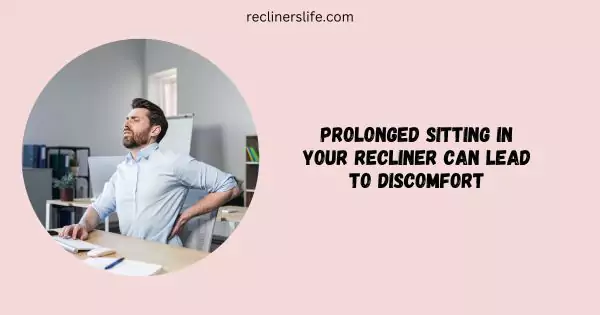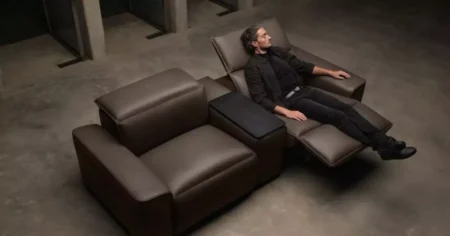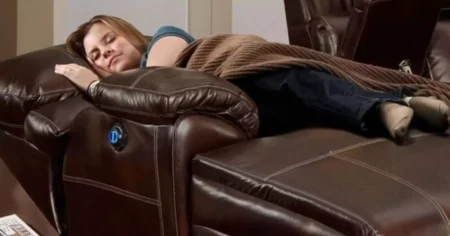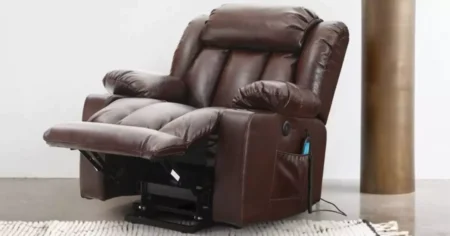If you suffer from back pain, you may have considered buying a recliner or using one that you already own to ease your discomfort.
But is a recliner bad for your back? The answer is not so simple.
Depending on how you use it, a recliner can either help or harm your back health.
In this article, we will explain the benefits and risks of using recliners for back pain, as well as some tips for choosing and using recliners safely and effectively.
Is Sitting in a Recliner Bad for Your Back?
Sitting in a recliner isn’t inherently bad for your back, but how you use it matters. A well-designed recliner with lumbar support can actually benefit your back health by maintaining proper posture and reducing strain.
However, prolonged and improper use, such as sitting for extended periods without movement, can lead to discomfort and poor posture.
Moderation, proper posture, and incorporating regular breaks and movement are key to enjoying the comfort of a recliner while safeguarding your back health.
5 Benefits of Recliners for Back Health
Recliners, no doubt, play a vital role in your back health. Let’s explore some of their benefits.
1. Lumbar Support
A well-designed recliner offers more than just comfort.

It provides excellent lumbar support by cradling the natural curve of your lower spine.
This support isn’t just cozy; it helps maintain proper posture, reducing strain on your back muscles and promoting overall back health.
2. Customizable Positions
Recliners are all about adaptability. They allow you to tweak your sitting angle, which does more than just cater to your comfort.
Adjusting the angle distributes your body weight evenly, relieving pressure on specific areas of your back.
This not only boosts comfort but also curbs the risk of stiffness.
3. Relaxation and Muscle Tension Relief
Recliners aren’t just a comfy spot for your favorite shows; they’re a remedy for muscle tension too.
When used correctly, they create a cozy cocoon that helps release built-up stress and tension. This relaxation contributes to improved overall back health.
4. Circulation and Blood Clot Prevention
Elevating your legs while reclining isn’t just about style; it’s health-savvy too. This posture tweak enhances blood circulation and acts as a barrier against blood clots.
This benefit becomes particularly valuable for individuals with circulation concerns or extended sitting periods.
5. Enhanced Sleep Quality
Sleep struggles? Recliners might just be your solution. Elevating your upper body slightly isn’t just about fighting gravity—it’s about fighting sleep apnea and snoring.
By promoting better airflow, recliners can enhance sleep quality, a huge boost for your back health.
3 Drawbacks of Recliners for Back Health
With benefits, recliner chairs can cause a disturbance if not used properly. Let’s explore some of their drawbacks.
1. Prolonged Sitting Discomfort
Yes, recliners are cozy, but too much of a good thing can strain your back muscles.

Prolonged lounging, even in a comfortable recliner, can lead to muscle discomfort and, over time, result in less-than-ideal posture.
2. Movement Suppression
As much as we love sinking into a recliner, it can discourage movement. Flexibility and motion are vital for preventing stiffness, and recliners, if overused, might stand in the way.
To counter this, remember to take breaks and incorporate stretches.
3. Core Weakening with Over-Reliance
While recliners offer support, they don’t actively engage your core muscles. Over time, relying solely on them can lead to weakened core strength.
A solid core is essential for back health. To balance this, blend your recliner moments with core-strengthening exercises.
How Do I Know if My Chair is Bad for Lumbar Support?
Determining whether your recliner is causing harm to your back requires some self-awareness. Consider these factors:
- Comfort vs. Discomfort: If you notice discomfort or pain while sitting in your recliner, it might be time to reassess its suitability for your back.
- Posture Check: Observe your posture while reclining. If you find yourself slouching or adopting an unnatural position, it’s a sign that the recliner might not be providing adequate support.
- Persistent Pain: If you experience persistent back pain after using your recliner, it’s a red flag. Consult a healthcare professional to rule out any serious issues.
How to Choose a Recliner for Your Back Support?
Selecting the right recliner can make a world of difference in maintaining your back health. Here’s how to choose wisely:
| Considerations | Benefits |
|---|---|
| Lumbar Support | Maintains natural spinal curve |
| Range of Motion | Customizable comfort and support |
| Quality Materials | Comfort and support |
| Try Before You Buy | Ensures comfort and back support with a test sit |
What is the Ideal Reclining Angle When Sitting?
Opting for a reclined angle ranging between 135 to 155 degrees often provides optimum comfort for most individuals.
- 135-155 degrees (Optimal): This range is considered optimal for many reasons. Not only does it encourage a natural alignment of your spine, but it also effectively minimizes pressure on your back. This sweet spot supports your back’s natural curves, reducing strain and discomfort.
- Less than 135 degrees (Unsupportive): Reclining at an angle less than 135 degrees can lead to unsupportive seating. It may place undue strain on your lumbar region and lead to poor posture. This angle fails to adequately distribute your body weight, potentially causing discomfort and muscular tension.
- More than 155 degrees (Over-reclined): Opting for a reclining angle exceeding 155 degrees might sound comfortable, but it comes with its drawbacks. While it might feel initially cozy, this extreme angle could eventually lead to discomfort and limited support. Over-reclining may compromise your back’s natural alignment and reduce the benefits of adequate lumbar support.
Conclusion
In a nutshell, recliners can be friends or foes for your back health.
When chosen wisely and used mindfully, they offer comfort and even relief. Remember, opt for lumbar support, find your sweet recline spot, and invest in quality.
Listen to your body, take breaks, and stay active. So, is a recliner bad for your back? Not if you make it your ally in comfort and care.
Frequently Asked Questions
Is It Unhealthy to Sit in a Recliner?
Sitting in a recliner isn’t inherently unhealthy. The key lies in moderation and posture. Opt for a recliner with lumbar support, maintain a balanced recline angle, and take breaks to prevent prolonged sitting.
What Is the Healthiest Way to Sit in a Recliner?
To sit healthily in a recliner, prioritize lumbar support. Choose an angle between 135 to 155 degrees for optimal spinal alignment. Keep breaks in mind, and incorporate movements and stretches to counteract prolonged sitting.
Do Doctors Recommend Recliners?
Yes, many doctors suggest recliners with proper lumbar support for individuals with back pain or circulation issues. When used correctly, recliners can provide comfort, aid in relaxation, and support back health.
What Happens If You Sit in a Recliner All Day?
Sitting in a recliner all day can lead to poor posture, muscle stiffness, and reduced mobility. It might strain your back and contribute to discomfort. It’s vital to balance recliner use with movement and ergonomic practices for better overall well-being.





